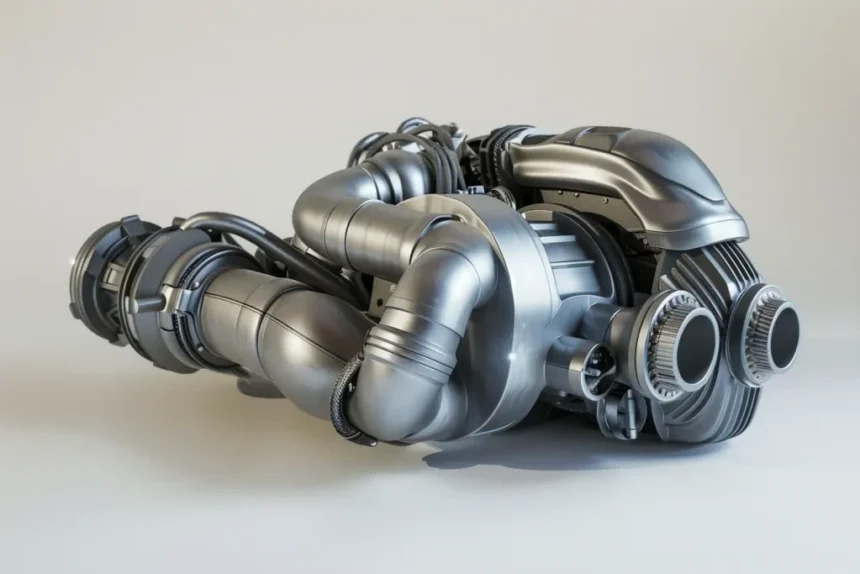When it comes to enhancing engine performance, the term “Turbo” is often at the forefront of the conversation. But what exactly is a turbocharger, and why is it so popular in the automotive and industrial sectors? In this comprehensive guide, we’ll explore everything you need to know about turbos, from their history and functionality to their benefits and applications.
What is a Turbo?
A turbocharger, commonly referred to as a “turbo,” is a device that forces more air into an engine’s combustion chamber. By compressing the air, a turbo increases the engine’s efficiency and power output without requiring a larger engine.
Key Components of a Turbocharger:
- Compressor: Draws in and compresses air.
- Turbine: Powered by exhaust gases to drive the compressor.
- Intercooler: Cools the compressed air for better performance.
- Wastegate: Regulates the flow of exhaust gases to prevent over-boosting.
How Does a Turbo Work?
A turbocharger works by utilizing the energy from exhaust gases that would otherwise be wasted. Here’s a step-by-step breakdown:
- Exhaust Gases Enter the Turbine: Hot exhaust gases from the engine spin the turbine.
- Turbine Drives the Compressor: The turbine is connected to the compressor via a shaft, causing the compressor to spin.
- Air is Compressed: The compressor draws in and compresses air, increasing its density.
- Compressed Air Enters the Engine: The denser air allows for more fuel to be burned, resulting in greater power output.
Benefits of Using a Turbo
Turbochargers offer a range of benefits, making them a popular choice for both personal and commercial vehicles. Here are some of the key advantages:
1. Increased Power
A turbocharger significantly boosts an engine’s horsepower without increasing its size.
2. Improved Fuel Efficiency
By optimizing the air-fuel mixture, turbos can improve fuel economy, especially in smaller engines.
3. Reduced Emissions
Turbocharged engines burn fuel more efficiently, leading to lower emissions.
4. Compact Design
Turbos allow for smaller, lighter engines that deliver the same or greater power as larger, naturally aspirated engines.
Types of Turbochargers
There are several types of turbochargers, each designed for specific applications. Below is a table summarizing the most common types:
| Type | Description | Applications |
|---|---|---|
| Single Turbo | A single turbine and compressor. Simple and cost-effective. | Passenger cars, light trucks |
| Twin-Turbo | Two turbos working in sequence or parallel for better performance. | High-performance vehicles |
| Variable Geometry | Adjustable vanes optimize airflow for better efficiency at different speeds. | Diesel engines, sports cars |
| Electric Turbo | Uses an electric motor to eliminate lag and improve response time. | Hybrid and electric vehicles |
For more insights into automotive trends, check out our latest articles on TrendsMag.
Common Applications of Turbochargers
Turbochargers are used in a variety of industries and applications, including:
1. Automotive
- Passenger cars
- Sports cars
- Trucks and SUVs
2. Aviation
- Turbocharged aircraft engines for high-altitude performance.
3. Marine
- Turbochargers in ships and boats for fuel efficiency and power.
4. Industrial
- Power generation and heavy machinery.
Turbo vs. Supercharger: What’s the Difference?
While both turbos and superchargers are designed to boost engine performance, they operate differently. Here’s a quick comparison:
| Feature | Turbocharger | Supercharger |
|---|---|---|
| Power Source | Exhaust gases | Engine belt or crankshaft |
| Efficiency | More efficient due to waste energy usage | Less efficient, as it draws power directly from the engine |
| Lag | May experience turbo lag | Instant response |
| Cost | Generally more affordable | Typically more expensive |
How to Maintain a Turbocharger
Proper maintenance is crucial for ensuring the longevity and performance of your turbocharger. Here are some tips:
- Use High-Quality Oil: Turbos rely on oil for lubrication and cooling.
- Allow Cool-Down Time: Let the engine idle for a minute after driving to cool the turbo.
- Regular Inspections: Check for leaks, unusual noises, or reduced performance.
- Replace Air Filters: Clean air filters prevent debris from damaging the turbo.
For more maintenance tips, visit our automotive care section.
The History of Turbochargers
The concept of turbocharging dates back to the early 20th century. Here’s a brief timeline:
- 1905: Swiss engineer Alfred Büchi patents the first turbocharger.
- 1920s: Turbochargers are used in aviation to improve high-altitude performance.
- 1960s: Turbos make their way into passenger cars, starting with the Chevrolet Corvair Monza.
- 2000s: Advances in technology lead to more efficient and reliable turbochargers.
Turbocharger FAQs
1. What is Turbo Lag?
Turbo lag is the delay between pressing the accelerator and the turbocharger delivering additional power. Modern turbos, such as variable geometry and electric turbos, are designed to minimize lag.
2. Can a Turbo Be Installed on Any Engine?
While it’s possible to retrofit a turbo on many engines, it requires significant modifications and expertise.
3. How Long Does a Turbo Last?
With proper maintenance, a turbocharger can last over 100,000 miles.
Conclusion
Turbochargers are a game-changer in the world of engines, offering increased power, efficiency, and versatility. Whether you’re a car enthusiast or simply looking to improve your vehicle’s performance, understanding how turbos work and their benefits is essential.
For more in-depth articles on automotive technology and trends, visit TrendsMag. Stay ahead of the curve with the latest insights and updates!





